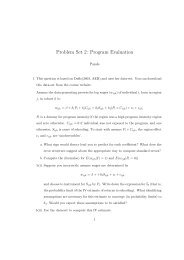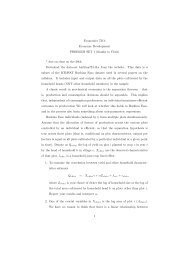The Expected Utility Model: Its Variants, Purposes, Evidence and ...
The Expected Utility Model: Its Variants, Purposes, Evidence and ...
The Expected Utility Model: Its Variants, Purposes, Evidence and ...
Create successful ePaper yourself
Turn your PDF publications into a flip-book with our unique Google optimized e-Paper software.
Schoemaker: <strong>The</strong> <strong>Expected</strong> <strong>Utility</strong> <strong>Model</strong><br />
543<br />
+ .5U(O), whereas the latter preference<br />
implies the reverse inequality. To see why<br />
this preference pattern violates the third<br />
EU axiom, note the following relationship<br />
between situations A <strong>and</strong> B:<br />
In prospect theory, Kahneman <strong>and</strong> Tversky<br />
(1979) provide several additional examples<br />
of this certainty effect, which they<br />
explain as the result of probability distortions.<br />
A related experiment on the effect of<br />
certainty vs. uncertainty was performed<br />
by Ellsberg (1961); however, his focus was<br />
on the probability dimension. He showed<br />
that people dislike ambiguity as to the exact<br />
level of the probability of winning (pi).<br />
<strong>The</strong> essential finding was that subjects<br />
look at more than the expected value of<br />
such a probability, when given some prior<br />
distribution as to its levels. This sensitivity<br />
to other moments is contrary to EU theory<br />
for which only E(f5i) matters.9 <strong>The</strong> Allais<br />
<strong>and</strong> Ellsberg paradoxes can both be shown<br />
to entail a violation of an alternative type<br />
of EU axiom, called Savage's independence<br />
or sure-thing principle (1954). This<br />
axiom holds that if two lotteries have an<br />
identical probability <strong>and</strong> payoff branch,<br />
the levels of this payoff <strong>and</strong> probability<br />
should not affect people's choice between<br />
the lotteries.<br />
<strong>The</strong> above violations particularly raise<br />
questions about the fifth EU axiom, i.e.,<br />
the assessment of compound lotteries. Direct<br />
evidence of its violation was offered<br />
A normative reply to the Ellsberg paradox can<br />
be found in RaifFa (1961), Harry Roberts (1963), <strong>and</strong><br />
Jacques Dreze (1974). Other discussions of the Ellsberg<br />
experiment <strong>and</strong> related paradoxes (e.g., Allais)<br />
are contained in William Fellner (1961), Selwyn<br />
Becker <strong>and</strong> Fred Brownson (1964), Karl Borch<br />
(1968), Kenneth MacCrimmon (1968), Frank Yates<br />
<strong>and</strong> Lisa Zukowski (1976), MacCrimrnon <strong>and</strong> Stig<br />
Larsson (1979), <strong>and</strong> Soo-Hong Chew <strong>and</strong> MacCrirnmon<br />
(1979b).<br />
by Maya Bar-Hillel (1973) who found that<br />
people tend to overestimate the probability<br />
of conjunctive events <strong>and</strong> underestimate<br />
the probability of disjunctive events.<br />
In her experiment subjects were presented<br />
with three events on which they<br />
could bet:<br />
1. A simple event: drawing a red marble from<br />
a bag containing 50 percent red <strong>and</strong> 50 percent<br />
white marbles.<br />
2. A conjunctive event: drawing a red marble<br />
7 times in succession, with replacement,<br />
from a bag containing 90 percent red marbles<br />
<strong>and</strong> 10 percent white marbles.<br />
3. A disjunctive event: drawing a red marble<br />
at least once in 7 successive tries, with replacement,<br />
from a bag containing 10 percent<br />
red marbles <strong>and</strong> 90 percent white marbles.<br />
<strong>The</strong> majority preferred bet 2 to bet 1.Subjects<br />
also preferred bet 1 to bet 3. <strong>The</strong><br />
probabilities of the three events, however,<br />
are .50, .48 <strong>and</strong> .52 respectively. <strong>The</strong>se<br />
biases can be explained as effects of anchoring:<br />
i.e., the stated probability of the<br />
elementary event (.l in the disjunctive<br />
case) provides a natural starting point<br />
from which insufficient adjustment is<br />
made to arrive at the final answer.<br />
A sixth postulate, not formally part of<br />
NM utility theory, is the traditional riskaversion<br />
assumption in economics <strong>and</strong> finance,<br />
particularly for losses (Friedman<br />
<strong>and</strong> Savage, 1948; Arrow, 1971; Isaac Ehrlich<br />
<strong>and</strong> Becker, 1972; J. Marshall, 1974;<br />
Martin Bailey et al., 1980). Recent laboratory<br />
studies, however, seriously question<br />
this pervasive assumption (also see, Harry<br />
Markowitz, 1952). For instance, John Hershey<br />
<strong>and</strong> Schoemaker (1980) found that<br />
less than 40 percent of their subjects<br />
would pay $100 to protect against a .O1<br />
chance of losing $10,000. Similar refusals<br />
to accept actuarially fair insurance were<br />
uncovered by Paul Slovic et al. (1977),<br />
Kahneman <strong>and</strong> Tversky (1979), Schoemaker<br />
<strong>and</strong> Howard Kunreuther (1979),<br />
<strong>and</strong> Fishburn <strong>and</strong> Gary Kochenberger<br />
(1979). Dan Laughhunn et al. (1981) found




